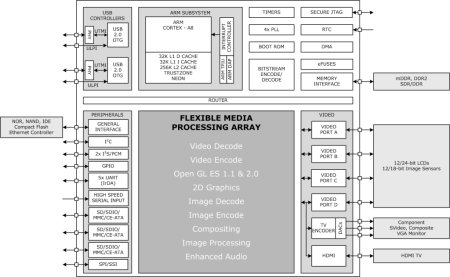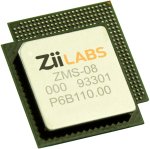HD-ready SoC moves up to Cortex-A8 core
Nov 11, 2009 — by Eric Brown — from the LinuxDevices Archive — 2 viewsZiiLabs is sampling a Cortex-A8 system-on-chip for HD-ready mobile devices that supports Android and ZiiLab's Linux-based Plaszma OS. Like ZiiLabs' ARM9-based ZMS-05 SoC, used in its Zii Egg PMP, the ZMS-08 supports 1080p H.264 decode and 720p videoconferencing, but it adds a 1GHz Cortex-A8 core and plus OpenGL ES 2.0 graphics.
The ZMS-08 system-on-chip (SoC) is aimed at web tablets, netbooks, connected TVs, video conferencing systems, and home media hubs, says ZiiLabs, a Creative Technology subsidiary that was founded in 2004 as the fabless semiconductor firm 3DLabs. In July, ZiiLabs began shipping a portable media player (PMP) called the Zii Egg StemCell Computer (pictured below) based on its homegrown, dual ARM9-core "ZMS-05" SoC and "Plaszma" Linux distribution. The Zii Egg offers a 3.5-inch display supporting 1080p HD video, plus an HD video camera, WiFi, GPS, and Bluetooth.

Zii Egg StemCell Computer
Like the ZMS-05, the ZMS-08 is supported by ZiiLabs' Linux-based Plaszma OS and related software development kit (SDK), as well as a "Zii Optimised Android" distribution. (For more on the ZMS-05, StemCell Computing, Plaszma, and the Zii Egg, see our original in-depth coverage here.)
By moving up to a 1GHz ARM Cortex-A8 core, said to make the SoC four times faster than the dual ARM9 ZMS-05, the ZMS-08 boosts video playback to Blu-ray quality and 60fps frame rates, while improving videoconferencing performance to 30fps, claims ZiiLabs. The ZMS-08 is also said to add OpenGL ES 2.0 2D/3D graphics support, with a touted 1 Gpixels/sec fill rate. Other touted new features include an integrated HDMI controller, dual USB controllers, Flash acceleration, and Xtreme Fidelity X-Fi audio.

ZMS-08 block diagram
(Click to enlarge)

New integrated peripheral functions include dual USB 2.0 OTG controllers with PHY and ULPI interfaces. In addition, four HD video processing units are said to support camera and display input and output processing in conjunction with the integrated HDMI and analog video encoders. Other I/O includes three SDIO/MMC ports, UARTs, SPI, and GPIO.
Naturally enough for a Creative Labs subsidiary, ZiiLabs is all pumped up about the SoC's audio support. The new X-Fi technology is built around a crystalizer that is said to intelligently restore audio detail lost during file compression.
X-Fi also incorporates "CMSS-3D" technology, which adds a surround sound experience for headphones and speakers while it "up-mixes stereo to sound great on surround sound speaker systems," says ZiiLabs. Audio processing modules available to ZMS-08 developer are said to include smart volume, dialogue enhancer, acoustic echo cancellation, graphic equalizer, microphone beam former, and noise reduction modules.
Stated Ian Drew, EVP marketing, ARM, "Combining advanced ARM technology with their own media processing IP has enabled ZiiLabs to deliver the high performance and low-power consumption required to enable the next leap in the mobile internet revolution."
Availability
The ZMS-08 is sampling to "certain customers" and is scheduled for volume shipment in the first quarter of 2010, says ZiiLabs. The chip is housed in a 13x13mm, 424-pin FBGA package. More information may be found here.
This article was originally published on LinuxDevices.com and has been donated to the open source community by QuinStreet Inc. Please visit LinuxToday.com for up-to-date news and articles about Linux and open source.